
Lomatia tasmanica, commonly known as King's lomatia, is a shrub of the family Proteaceae native to Tasmania. Growing up to 8 metres (26 ft) tall, the plant has shiny green pinnate (lobed) leaves and bears red flowers in the summer, but yields neither fruit nor seeds. King's lomatia is unusual because all of the remaining plants are genetically identical clones. Because it has three sets of chromosomes and is therefore sterile, reproduction occurs only vegetatively: when a branch falls, that branch grows new roots, establishing a new plant that is genetically identical to its parent.

Carpinus caroliniana, the American hornbeam, is a small hardwood understory tree in the genus Carpinus. American hornbeam is also known as blue-beech, ironwood, musclewood and muscle beech. It is native to eastern North America, from Minnesota and southern Ontario east to Maine, and south to eastern Texas and northern Florida. It also grows in Canada. It occurs naturally in shaded areas with moist soil, particularly near the banks of streams or rivers, and is often a natural constituent understory species of the riverine and maritime forests of eastern temperate North America.

Lomatia is a genus of 12 species of evergreen flowering plants in the protea family Proteaceae. Within the family, they have been placed, alone, in their own subtribe, Lomatiinae according to Johnson & Briggs 1975 classification of the family and subsequently in Flora of Australia (1995).

Quercus dentata, also called Japanese emperor oak or daimyo oak is a species of oak native to East Asia. The name of the tree is often translated as "sweet oak" in English to distinguish it from Western varieties. It is placed in section Quercus.

Castanea pumila, commonly known as the Allegheny chinquapin, American chinquapin or dwarf chestnut, is a species of chestnut native to the southeastern United States. The native range is from Massachusetts and New York to Maryland and extreme southern New Jersey and southeast Pennsylvania south to central Florida, west to eastern Texas, and north to southern Missouri and Kentucky. The plant's habitat is dry sandy and rocky uplands and ridges mixed with oak and hickory to 1000 m elevation. It grows best on well-drained soils in full sun or partial shade.

Banksia dentata, commonly known as the tropical banksia, is a species of tree in the genus Banksia. It occurs across northern Australia, southern New Guinea and the Aru Islands. Growing as a gnarled tree to 7 m (23 ft) high, it has large green leaves up to 22 cm (8.7 in) long with dentate (toothed) margins. The cylindrical yellow inflorescences, up to 13 cm (5.1 in) high, appear between November and May, attracting various species of honeyeaters, sunbirds, the sugar glider and a variety of insects. Flowers fall off the ageing spikes, which swell and develop follicles containing up to two viable seeds each.
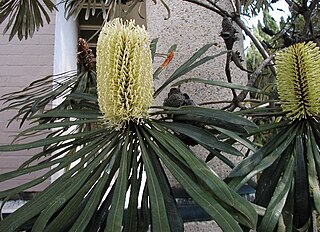
Banksia aquilonia, commonly known as the northern banksia and jingana, is a tree in the family Proteaceae and is endemic to north Queensland on Australia's northeastern coastline. With an average height of 8 m (26 ft), it has narrow glossy green leaves up to 20 cm (7.9 in) long and 6 to 10 cm high pale yellow flower spikes, known as inflorescences, appearing in autumn. As the spikes age, their flowers fall off and they develop up to 50 follicles, each of which contains two seeds.
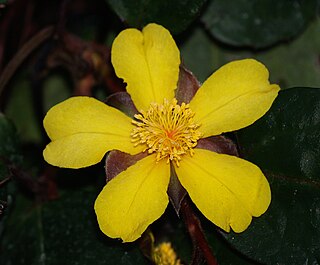
Hibbertia dentata, commonly known as toothed guinea flower, trailing guinea flower or twining guinea flower, is an ornamental plant in the family Dilleniaceae native to the east coast of Australia. Found in woodland, it is a trailing or twining vine with leaves with several small 'teeth' on the margins and bright yellow flowers in early spring. It adapts readily to cultivation and can be grown as a pot plant. The species was first described in 1817.

Maytenus magellanica is a small evergreen tree from the genus Maytenus, up to 5 meters (16 ft), in the Celastraceae. It grows in southern Argentina and Chile from 36ºS to Cape Horn (56ºS).

Pitavia punctata is a species of tree endemic to Chile in the family Rutaceae. It is known by the common names Pitao and Pitran. It grows in native deciduous forests in the Chilean Coast Range of central Chile. It is threatened with habitat loss, and is assessed as Endangered.
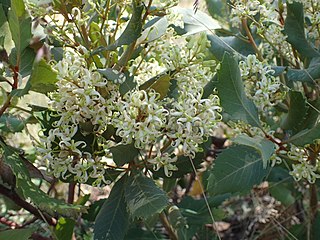
Lomatia fraseri, commonly known as tree lomatia, forest lomatia or silky lomatia is a plant of the family Proteaceae native to eastern Australia. It grows as a shrub or small tree, reaching 8–11 metres (26–36 ft) high, with highly variable leaves. The cream to white inflorescences appear over summer. It is found in rainforest margins, gullies and heathland in mountainous regions of Victoria and New South Wales. It regenerates from fire by regrowing from a lignotuber.

Lomatia ferruginea, commonly known as fuinque, is a small evergreen tree in the family Proteaceae.

Myrceugenia obtusa, also known as raran, is an evergreen tree endemic to Chile from Coquimbo to Cautin. It grows mainly in the coastal mountains on moist sites.

Lomatia hirsuta, known as radal, is a tree native to Argentina, Chile, and Peru.
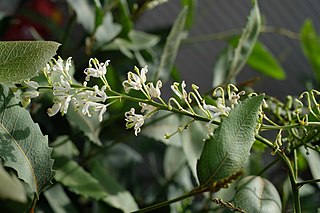
Lomatia ilicifolia, commonly known as holly lomatia or native holly, is a plant in the family Proteaceae and is endemic to south-eastern Australia. It is a stiff, erect shrub with hairy, rust-coloured new growth and which recovers from fire from a lignotuber. It has dull green, leathery, prickly, holly-like leaves and long sprays of cream flowers, usually after fire.

Lomatia myricoides, commonly known as the river lomatia, is a shrub native to New South Wales and Victoria in southeastern Australia.

Lomatia arborescens, commonly known as smooth lomatia or tree lomatia, is a shrub or small tree that grows at high altitudes, in and near rainforests. It is found north from the Barrington Tops area in eastern Australia.
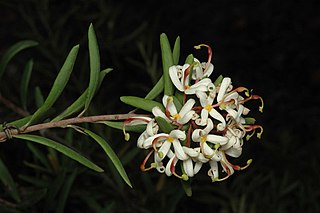
Lomatia polymorpha, commonly known as mountain guitar plant, is a shrub or small tree of the family Proteaceae which is endemic to Tasmania. It is a shrub or small tree with linear leaves, and white, cream-coloured or greenish flowers. It is common throughout its range which is approximately complementary to that of L. tinctoria in Tasmania.
Myrceugenia colchaguensis is a species of small evergreen tree in the genus Myrceugenia of the family Myrtaceae. It is endemic to Chile where it is found in the coastal mountain range at altitudes below 400 m (1,312 ft). Common names by which this tree is known include colchaguillo, arrayan de colchagua and lumilla.

Brachyscome dentata, commonly known as lobe-seed daisy, is a tufted perennial herb in the family Asteraceae and is endemic to Australia. It has mostly white or mauve daisy-like flowers, a yellow centre and pale green leaves. It is endemic to Australia.



















